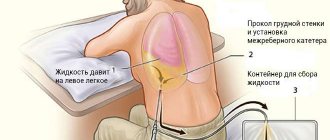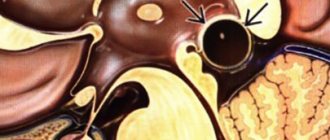Astrocytoma is one of the most common brain tumors. The inside of the tumor often contains cysts, which can grow to large sizes and cause compression of the brain matter.
Benign astrocytomas, located in an accessible location, give a better prognosis for life expectancy than high-grade astrocytomas or benign astrocytomas, located in a location inaccessible to the surgeon and having a large tumor size. The earlier a tumor is detected, the better the prognosis for its treatment.
At the Yusupov Hospital they deal with the diagnosis and treatment of astrocytes. The hospital is equipped with innovative diagnostic equipment that allows you to receive all diagnostic services.
Etiology of cerebral astrocytoma
The exact causes of the tumor are still being investigated by scientists. However, it is possible to identify a complex of factors that can provoke the disease. For a long time, scientists believed that astrocytes perform an exclusively supportive function in relation to the neurons of the central nervous system. However, recent research shows that astrocytes also perform a protective function, as they prevent injury to neurons and absorb chemicals resulting from their activity.
The trigger for the appearance of a tumor in the brain can be the patient’s genetic predisposition to cancer. The causes of the disease also include viruses with a high level of oncogenicity and unfavorable environmental conditions. Professional activity can also play a decisive role in the appearance of a tumor. For example, workers who work in oil refining and rubber production are at risk of developing brain astrocytoma.
Radiation exposure may also be a risk factor. It has been proven that in patients with other forms of cancer who have undergone radiotherapy, the risk of developing a tumor is several times higher. As for the patient’s age, astrocytoma can appear in both older people and children. However, the average age of patients at the time of diagnosis is usually around 9-10 years.
Biological behavior and follow-up
Diffuse astrocytomas may be described in the literature as “low-grade astrocytomas” or “benign astrocytomas.” Based on observation of tumors of this group, it turns out that all of them in their development increase the degree of anaplasia and dedifferentiate into tumors with a higher histological grade of malignancy: first to anaplastic astrocytoma, and then to glioblastoma, which is a sequential chain in the development scenario of most gliomas. Thus, this class of tumors is potentially malignant, although it does not have typical signs at this stage under microscopy. Fibrillary astrocytoma has the most benign course in relation to other diffuse astrocytomas.
In a dynamic analysis of a series of observations of a tumor with bilateral damage to the thalamus and pons, an increase in the size of the formations is evident, as well as the development of replacement hydrocephalus against the background of atrophy of the medulla due to tumor progression and the consequences of treatment (Fig. 186).
General symptoms of astrocytoma
As for the general symptoms, they are often caused by the toxic effects of tumor cells and increased intracranial pressure. General symptoms also appear:
- convulsions;
- Strong headache;
- weakening of concentration and memory;
- speech disorders;
- weakened vision;
- unsteady gait;
- nausea, vomiting.
The patient may also experience hallucinations, problems with writing and fine motor skills. Patients often experience changes in character and frequent mood swings. General symptoms of the disease can be either constant or paroxysmal. In many ways, their manifestation depends on which particular area of the brain the astrocytoma appears in.
Literature
- B.V. Gaidar, T.E. Rameshvili, G.E. Trufanov, V.E. Parfenov, Radiation diagnostics of tumors of the brain and spinal cord - St. Petersburg: FOLIANT Publishing House LLC, 2006-336p.
- V.N. Kornienko and I.N. Pronin Diagnostic neuroradiology Moscow 2009 0-462.
- Abdullah ND, Mathews VP (1999) Contrast issues in brain tumor imaging. Neuroimaging Clin North Am 9(4):733–749 Abul-kasim K,
- Thurnher MM, Mckeever P et-al. Intradural spinal tumors: current classification and MRI features. Neuroradiology. - 2008;50 (4): 301-14.
- Agrawal V, Ludwig N, Agrawal A et al. Intraosseous intracranial meningioma. AJNR Am J Neuroradiol. 2007;28(2):314-5
- Presentation “Positron emission tomography in neurology and neuro-oncology” INSTITUTE OF THE HUMAN BRAIN named after. N.P. Bekhtereva RAS author E.S. Malakhova.
Focal symptoms of astrocytoma
As for the focal symptoms of the disease, they are caused by compression and destruction of the cerebral areas located near it by the tumor. Namely, if the astrocytoma is located in the frontal lobe, the patient complains of frequent mood swings and changes in character. Damage to the temporal lobe of the brain is accompanied by difficulty in coordination, memory and speech. A tumor in the parietal lobe of the brain causes difficulties with writing and motor skills. If the astrocytoma is located in the occipital region, the patient complains of hallucinations and visual disturbances, in the cerebellum - of difficulties maintaining balance.
Characteristics of astrocytomas
Astrocytomas are brain tumors that grow from astrocytes. The latter are studied by histology and represent cells of the nervous system. Their task is to perform supporting and restrictive functions. They can be protoplasmic, located within the gray matter, or fibrous, located in the white matter. Astrocytes ensure the transfer of elements necessary for the body between nerve cells and blood vessels.
Tumors of this type can appear on both the left and right sides of the brain. In adults, astrocytomas usually form in the white matter or brain stem. Children most often have to deal with a tumor of the cerebellum or optic nerve. Cysts may appear inside the tumor itself. They develop very slowly, but can reach significant sizes and negatively affect the lobes of the brain. Sometimes, upon diagnosis, astrocytomas themselves also turn out to be quite large, which makes it impossible to determine clear boundaries.
According to the ICD, astrocytomas are classified as malignant tumors with code C71. Additionally, the location of the tumor is clarified. If the neoplasm is benign, the disease code will be D33. In this case, its localization is also taken into account.
Diagnosis of brain astrocytoma
To make a diagnosis, doctors use a set of techniques. Tomography helps to obtain the most accurate and reliable information about the tumor:
- magnetic resonance imaging: capable of recognizing the degree of malignancy of a tumor, since during its examination the areas feeding the tumor are illuminated with bright and saturated light;
- computer: allows you to obtain a layer-by-layer image of the brain, which makes it possible to identify the structure and location of the tumor;
- positron emission: involves the injection into a vein of a small amount of radioactive glucose, which will accumulate in the tumor area.
The doctor can make an accurate diagnosis after performing a biopsy. To do this, a small piece of affected tissue is taken from the patient for examination. A biopsy is performed using surgical methods or endoscopy. The doctor can plan the operation in detail after angiography. The procedure involves the introduction of a special dye, which makes it possible to identify the vessels feeding the tumor. A neurological examination is used as an auxiliary diagnostic technique.
Contrast enhancement
There may be minimal contrast or its complete absence, which indicates a preserved BBB, but this does not at all mean that this formation is benign, or characterizes this process as non-tumor growth.
After intravenous contrast enhancement, there is no accumulation of the contrast agent (Fig. 177-179).
In cystic astrocytomas there is also no accumulation of contrast agent after contrast enhancement (Fig. 180-182).
The appearance of areas with contrast enhancement characterizes an increase in the degree of anaplasia of the contrast-enhanced areas [2].
Zones of increased MR signal on T1 (arrowheads in Fig. 183-185) indicate a local violation of the integrity of the BBB and an increase in cellular atypia.
Treatment of brain astrocytoma
Treatment tactics for cerebral astrocytoma are selected depending on the results of diagnostic studies. The following methods are used to treat the disease:
- Surgery. Surgery is chosen to remove low-grade astrocytoma. Since in some cases complete removal of the tumor is impossible, doctors may additionally prescribe a course of radiation therapy. However, in the early stages, the use of auxiliary techniques is not always effective, so doctors usually wait for new symptoms to appear. If, due to the large size of the tumor, it is impossible to completely remove it, doctors concentrate on reducing its size.
- Radiation therapy. This technique is aimed at damaging cells involved in cell nutrition. Healthy brain tissue is not affected. Radiation therapy is usually performed in courses. It is carried out in two ways: the internal impact technique involves the introduction of radioactive materials into the damaged tissue, and the external impact tactics involve the location of the radiation source outside the body.
- Chemotherapy. This technique involves prescribing special medications to the patient that can destroy tumors. After such drugs enter the blood of a sick person, they begin to intensively destroy the areas affected by the tumor. The disadvantage of chemotherapy is that healthy cells often die along with damaged cells. Today, chemotherapy drugs are produced in the form of injections, tablets, and catheters.
- Radiosurgery. Radiosurgery is performed as follows: diseased cells are exposed to direct radio radiation, after which they die. The advantage of this technique is the ability to make calculations for the exact effects of radiation using a computer program. In this way, it is possible to ensure that precise rays are directed only at the tumor, and not at healthy areas of the brain.
Differential diagnosis
Acute ischemic cerebrovascular accident
Territorial ischemic stroke, resulting from thrombosis or embolism, leads to the occurrence of cytotoxic edema strictly within the blood supply of the corresponding artery. Astrocytoma does not comply with the anatomical topography of the blood supply zones. A stroke in the first hours of its occurrence sharply limits diffusion and is manifested by an increased MR signal on DWI, and the infarction zone accumulates contrast with intravenous enhancement from about the 3rd day and can be contrasted up to the 3rd week with a characteristic gyral type. When performing MR angiography in a stroke with the presence of arterial thrombosis, a loss of signal from the blood flow is visualized.
The area of ischemic stroke has similar T2 and Flair MR signal characteristics to diffuse astrocytoma (arrowheads in Fig. 193). In the subacute phase, the area of ischemic stroke accumulates the contrast agent according to the gyral type (arrows in Fig. 194). On DWI, the area of ischemic infarction has a significantly higher MR signal than the area affected by fibrillary astrocytoma (arrows in Fig. 195). In the case of a territorial infarction against the background of atherothrombosis or embolism, MRA will visualize the absence of blood flow through the main artery (arrow head in Fig. 195).
With dynamic MRI and CT observation, the stroke zone evolves into an area of encephalomalacia, and subsequently into a cyst filled with cerebrospinal fluid and a glial shaft along the periphery. Fibrillary astrocytoma, when assessed over time, increases the size of the affected area and acquires the signs of anaplastic astrocytoma. Fibrillary astrocytoma does not accumulate contrast, however, it can limit diffusion, creating difficulties in differential diagnosis with infarction in the first 3 days.
Fibrillary astrocytoma in the right temporal and insular lobe in the form of an area without clear contours, simulating a stroke (arrowheads in Fig. 196), does not accumulate contrast agent (Fig. 197) and persists for a long time without dynamics. 1-2 months after an ischemic stroke, an area of encephalomalacia will be visualized in the affected area, resulting in cystic-glial changes (arrows in Fig. 198).
Anaplastic astrocytoma
Anaplastic astrocytoma at the macroscopic level has pronounced perifocal edema, mass effect and accumulates the contrast agent quite well, and sometimes hemorrhages into the tumor occur. In some cases, it is extremely difficult to make a differential diagnosis due to the progressive evolution of low-grade atrocytoma into anaplastic one, which is always inevitable.
Cystic anaplastic astrocytoma in the left temporal lobe (asterisk in Fig. 199,200), surrounded by perifocal edema (arrowheads in Fig. 199,200) and intensively accumulating contrast agent (arrows in Fig. 201).
Oligodendroglioma
According to MRI, the morphology of astrocytoma and oligodendroglioma leaves virtually no chance of a correct decision, however, on CT, calcifications are detected in oligodendrogliomas in 90% of cases.
The Flair MR signal intensity and tumor structure in fibrillary astrocytoma and oligodendroglioma can be very similar (arrowheads in Fig. 202, 203), however, oligodendroglioma often contains calcifications that are clearly visible on CT (arrow in Fig. 204) and can be visible on T2*.
Viral encephalitis
Viral encephalitis is accompanied by an inflammatory-necrotic process with hemorrhages, edema and necrosis, most often localized in the temporal lobe, often bilateral, with contrast enhancement - the accumulation of the agent leads to an increase in the MR signal in the area of the sulci. The clinical picture is accompanied by fever and impaired consciousness.
Cerebral gliomatosis
In the classification of brain tumors by histotypes from 2021. cerebral gliomatosis is considered to be an advanced form of diffuse astrocytoma. Thus, differential diagnosis is supposedly not required, however, it is still not clear how some forms of diffuse astrocytoma, with a small size, undergo anaplastic degeneration, while others immediately affect large areas of the brain with long-term static conditions, leading to a picture of extensive areas of damage.
Gliomatosis of the brain is an extensive lesion due to glial proliferation, covering at least 2 lobes (asterisks in Fig. 208, 209). The affected areas do not accumulate the contrast agent (Fig. 210).
Cerebral gliomatosis does not have any specific tumor node, but only areas of a more concentrated concentration of tumor cells, does not have cysts and has minimal mass effect. There is no contrast in both cases. Gliomatosis cerebri is much less common than astrocytomas and prefers older people, while diffuse astrocytomas predominantly affect young and middle-aged people.
Hydromyelia
Hydromyelia (syringomyelia) is an enlargement of the central canal of the spinal cord as a result of impaired cerebrospinal fluid dynamics caused by spinal stenosis or narrowing of the foramen magnum. Syringomyelia is often associated with Chiari malformation type I. With a pronounced expansion of the central canal, severe atrophy of the spinal cord occurs. There is no volumetric component in hydromyelia, no contrast enhancement is observed.
The combination of Chiari malformation type I (arrows in Fig. 211,213) and syringomyelia is an expansion of the central canal of the spinal cord against the background of liquorodynamic disorders (asterisks in Fig. 211). Hydromyelia can be so pronounced that the spinal cord will look like a hollow tube with a thin wall (arrow heads in Fig. 212), but it may not be pronounced (arrow heads in Fig. 213).
With a diffusely growing astrocytoma of the spinal cord, there may also be an expansion of the central canal, but there is an accumulation of contrast in the tumor tissue. The expansion of the central canal is not pronounced, there are no signs of spinal cord atrophy at the level of the lesion.
Astrocytoma of the spinal cord is accompanied by an increase in the T2 MR signal from the spinal cord, simulating the expansion of the central canal in syringomyelia (arrowheads in Fig. 214). After IV enhancement, there is an accumulation of contrast in the affected area (arrows in Fig. 215-216).
Prognosis of brain astrocytoma
The prognosis for the patient depends on several factors: the degree of malignancy, cases of relapse, which are most often observed in the first three years after surgery, as well as frequent changes in the stages of tumor development. For patients in whom the first stage of the disease is detected, the prognosis is generally favorable. However, even in this case, the patient’s life expectancy is significantly reduced - he can live about 9-10 years. For the second stage of the disease this figure is 5 years, for the third - 2-5 years, for the fourth - no more than one year.
Treatment of astrocytoma involves the use of complex techniques, so many patients experience various complications upon completion. Namely, after treatment of the tumor, speech disorders, disorders of the nerve endings that are responsible for touch, perception and taste buds, and impaired motor and support functions may occur.
Severe complications can be avoided if the disease is detected in time, at the first stage of its development. Timely treatment will help to significantly improve the quality of life and increase its duration. It is best not to delay treatment, as the tumor may begin to grow quickly. Doctors also advise people whose relatives have had cancer to undergo regular medical examinations and also avoid working in hazardous work environments.
Forecast
With nodular forms, after their surgical removal, a long-term remission (more than 10 years) is possible. Diffuse astrocytomas have frequent relapses, even after combination therapy. Life expectancy is on average 1 year for glioblastomas, and up to 5 years for anaplastic astrocytomas. Life expectancy for other astrocytomas is many years. Patients return to work and a full life.
In the program “Live Healthy!” conversation with Elena Malysheva about astrocytoma (see from 32:25 min.):
Disease prevention
Unfortunately, any neoplasm can occur even in a completely healthy person without a genetic predisposition. There are no ways to protect yourself from tumors. However, there are several medical recommendations that will help significantly reduce the risk of tumors:
- Adhere to a healthy diet, excluding fatty, fried, overly sweet and salty foods as much as possible. Every day you need to eat a lot of fiber and eat animal protein.
- Give up any bad habits.
- If possible, avoid stress or take special vitamin preparations prescribed by your doctor.
- If you hit your head or suspect a traumatic brain injury, be sure to go to the emergency room, as some processes may be asymptomatic.
- If possible, refuse work involving radioactive and chemical substances.
And of course, you must undergo an annual medical examination. Since the first stages of the disease are asymptomatic, it can only be detected during a CT or MRI. Remember: the sooner you start treatment, the greater the chances of getting rid of the disease.








